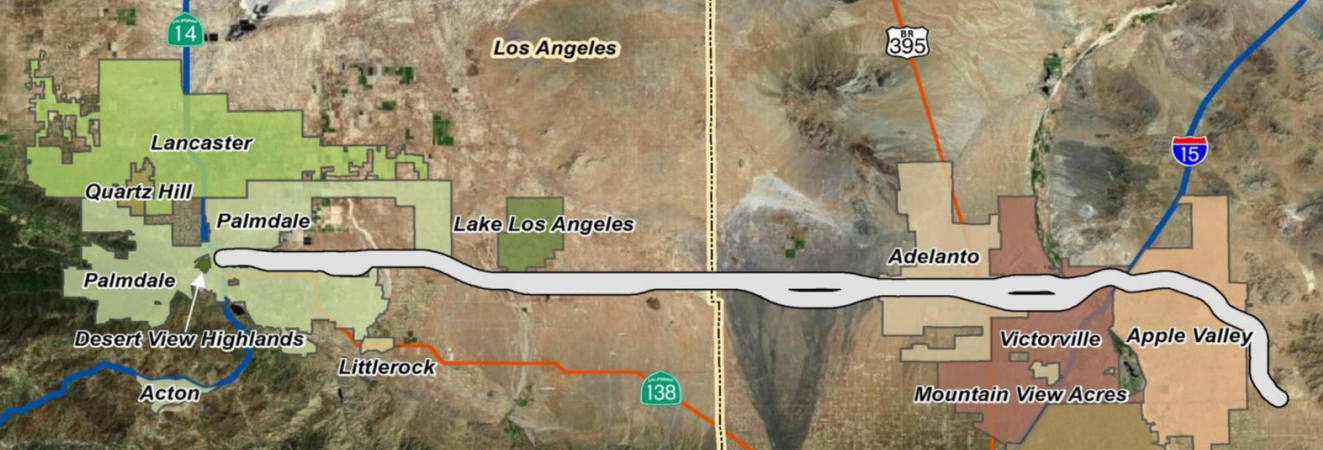In this year's installment of its annual “Highway Boondoggles” report, Gideon Weissman of Frontier Group and Matthew Casale of U.S. PIRG Education Fund deliver a stark warning about the billions of dollars states spend on unnecessary highways that fracture our cities, deprive transit of scarce funds, and pollute our environment. Below is the fourth of nine installments detailing case studies of these harmful roadways: L.A. County’s first new highway in 25 years, which would lead to more driving and more pollution, along with sprawling desert development.
California officials are moving forward with plans for the “High Desert Freeway,” an $8-billion, 63-mile freeway 40 miles north of downtown Los Angeles that would connect the cities of Palmdale and Lancaster with Victorville, Apple Valley and Adelanto. L.A. County’s first new highway in 25 years would lead to more driving and more pollution, along with sprawling desert development.
The plan, which would build a massive highway connecting mid-sized exurbs of Los Angeles, has inherent problems. The highway’s many proposed off-ramps in rural, undeveloped areas would encourage sprawl in fragile desert ecosystems, where development could alter the landscape and strain scarce water resources. Officials have not yet found full project funding, but the high cost of the highway may mean less money for other state or local transportation priorities.
The project would also increase California’s global-warming emissions in direct opposition to state goals. When it comes to taking on global warming, California is on the cutting edge in most ways. The state has more solar panels and more electric vehicles than any other in the country by far. In 2018, California adopted legislation requiring the state to generate 100 percent of its electricity using clean energy sources by 2045.
But for California to truly become a low-carbon state, it must work to reduce driving. Transportation is responsible for 46 percent of state carbon dioxide emissions, and the 151 million metric tons of on-road transportation emissions released in 2016 were more than the total, economy-wide emissions of states like Georgia, North Carolina and New Jersey. Electric vehicles constitute an important tool to reduce transportation emissions. But electrifying the existing 35 million vehicle fleet will take time, and walking, biking and transit can cut emissions now and play a role in the state’s long-term emissions reduction strategy.
According to the California Air Resources Board, in order to hit 2030 climate goals the average Californian must reduce driving by 1.6 miles a day. The High Desert Freeway will achieve the opposite. According to the most conservative scenario in the project’s Final Environmental Impact Statement, building the highway would increase driving by millions of vehicle miles traveled each year and increase annual carbon dioxide emissions by 240,000 metric tons per year, equivalent to burning 262 million pounds of coal.
In a nod to California’s climate goals, the project’s environmental impact statement claims the project will have emissions benefits, as a result of helping passengers use future rail routes and its inclusion of “green energy features.” Neither claim makes sense.
First, the document claims a benefit of providing “improved access and connectivity to” the proposed XpressWest high-speed rail route, which would be on a route parallel to the proposed highway. Such a rail route could, on its own, be an effective way to promote low-carbon travel.
In contrast, the highway would promote sprawling development less amenable to rail travel, and will also compete with, not provide service to, those rail stations. The document also claims the highway project will contribute “to state greenhouse gas reduction goals through the use of green energy features.” Yet it is unclear how green energy features like solar panels would benefit from the construction of a highway, or why existing highways could not provide similar building opportunities.
Sponsored post: Spin and Better Block Foundation are calling on designers, urbanists and anyone who cares about safe and livable streets, to submit ideas for a new generation of multimodal parklets. Winning designs will get built and installed in Denver in September. Let’s take back our streets from cars, one space at a time. Apply now: https://www.spin.pm/streets






